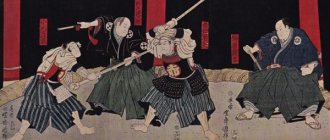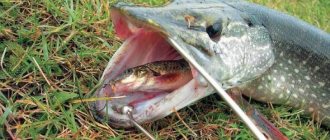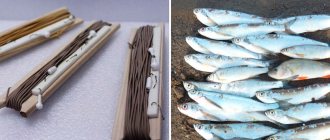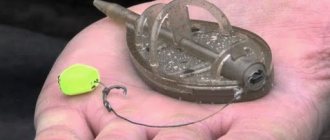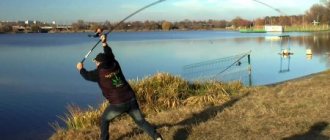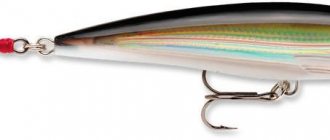What is a sword
Before talking about wielding a sword, you must first understand what it is and how it differs, for example, from a sword or saber. So, a sword is, of course, a type of bladed weapon with a non-curved blade more than 60 centimeters long. It is intended primarily for slashing, which is why it is also called a type of offensive weapon. It is also possible to deliver piercing blows with a sword.
How is iaido different from iaijutsu?
It cannot be said that iaido and iaijutsu are diametrically opposed or non-overlapping disciplines. Iaijutsu is a component of Iaido. If you imagine iaido and iaijutsu as Euler circles, then the iaijutsu circle will be located inside the iaido circle.
Iaijutsu is the practical side of mastering the skill of instantaneous sword strike. This is a discipline that teaches only one skill - the ability to quickly draw a sword from its sheath and strike accurately. Iaijutsu arose before iaido and was an auxiliary discipline of kenjutsu.
Iaido is a general combat discipline that includes not only sword strikes, but also ideological and philosophical ideals. Iaido does not require a high speed of strikes from the practitioner, but it does require complete calmness and concentration. It is in Iaido that the main practice is kata. It allows the practitioner to better know himself and his body.
Sword: history of weapons
In general, it should be noted that swords, due to various factors and reasons (they will be discussed later), have always been quite expensive weapons, not accessible to everyone; despite this, it was not anything else, but the sword and shield that became the true symbol of warfare and a real warrior.
As a predecessor of the sword, historians usually call a club, or a club - it was made of stone or very hard wood, and its edges were extremely sharp, capable of cutting. With the development of metals, people learned to create real swords. The first of them were bronze and appeared so long ago that it’s hard to believe - right at the beginning of the second millennium BC. Until the end of the sixteenth century, edged weapons (swords, in particular) were very popular among Europeans, later giving way to sabers and swords; As for Rus' and its inhabitants, their interest in the sword faded even earlier - it was replaced by the same saber (in the fourteenth century).
Since ancient times, the sword has been considered both a combat and hunting weapon. We won’t talk about the last function of the sword, but we’ll tell you about this weapon as a means of battle. In this regard, it is appropriate to return to the question of why the sword was an expensive pleasure.
History of the formation of the fighting style
As an independent technique, iaido (then still iaijutsu) emerged in the 16th century, at the end of the period of civil strife (Sengoku Jidai) and the beginning of the peaceful Tokugawa era. Its founder was Hayashizaki Shigenobu, about the vicissitudes of whose life path there are many legends. Through long meditative practices and physical training, Shigenobu created a fighting style called "Shimmei Muso Ryu", which translated means "divine, without equal." This is the most famous, basic style of Iaido, which today is called “Eishin Ryu”. The technique of instantly drawing a sword, created by Shigenobu, became incredibly popular in the 16th century.
“Tosa iai” is one of the main styles of iaijutsu, it is associated with Hayashizaki Shigenobu himself. It existed for a long time in the province of Tosa (after which it was named). Today Tosa is part of Kochi Prefecture. At the beginning of the 20th century, it became known outside the island of Shikoku thanks to Oe Masamichi and Nakayama Hakudo, masters of the Tosa branch of iai. They created two new styles of Iaido called "Muso Jikiden Eishin-ryu" and "Muso Shinden-ryu". New styles helped iaido maintain its popularity during the period of Europeanization of Japanese culture.
The first All Japan Kendo Federation, created after World War II, decided that real swords should also be used in Iaido and Kendo training, and not just the prop swords that students had previously used. In order to introduce such a practice, it was necessary to formulate general standards and safety rules for all old individual techniques, which turned out to be impossible. After this, it was decided to create a new movement that would comply with all the rules, and it would also be possible to use real swords.
The best masters of their time, students of Oe Masamichi and Nakayama Hakudo, were involved in the creation of a new unified style. With their help, a unified set of practices was created, which was simply called “Iaido of the All-Japan Kendo Federation” (“Zen Nihon Kendo Renmei Iaido”). The second name of this technique is “Seitei Iaido” - translated as “standard Iaido”. The new style was introduced in 1969 and soon became the most widespread branch of Iaido.
The emergence of a new universal style did not lead to the destruction of traditional koryu - seitei iaido is often considered only as the first step towards learning the iaido style.
Features of the sword
The high cost of this type of bladed weapon is directly related to its characteristics. So, for example, the length of the sword blade is quite long - about sixty (or even more) centimeters, but despite this, it is always sharpened to its entire length. This solution allows the strike to hit a much larger area. In addition, this increases the chances of hitting the bull's eye and provides a rather impressive list of sword techniques.
Another feature of this weapon is that its production itself is quite labor-intensive and requires much more costs than the same sabers, say, or swords. The creation of swords requires more metal, the material for such a product must be of really high quality, and the manufacture of the blade can only be entrusted to a highly qualified specialist. As you can easily guess, this factor also does not reduce the cost of the finished weapon.
The price is also affected by the need to constantly maintain the blade in proper condition—sharp, which is also quite costly in both effort and time. The fact is that a dull blade when striking in sword fencing will not bring the desired result. The weapon practically does not cause blunt trauma, which means it becomes useless. Useless in battle - we are talking about a combat sword!
This type of edged weapon still has enough of its own characteristics, both positive and negative, inherent only to it, however, they do not have an impact on the formation of value - unlike the above factors.
Federation
There are no separate federations for Iaido, because Iaido is often considered a subdiscipline of Kendo - Japanese sword fencing.
- International Kendo Federation (FIK)
The International Kendo Federation holds not only competitions (it organizes the largest kendo tournament - the World Kendo Tournament (WKC)), but also educational events - various seminars and lectures about kendo and iaido.
IFC was founded in 1970. It brings together all regional kendo federations. Initially, it included 17 countries, and by September 2021 this number increased to 59, including Russia.
- All Japan Kendo Federation
The All Japan Kendo Federation holds a variety of Iaido competitions. She also conducts certification for kyu and dan. The All Japan Kendo Federation was founded in 1952, and in 1969 it developed and introduced “standard iaido”, which is now taught by thousands of amateurs and professionals around the world. On the federation website you can find information about competitions and certifications, as well as information about your own exam and rank. The site is available in Japanese and English.
- Russian Kendo Federation
The Russian Kendo Federation holds competitions in kendo and iaido. The organization was founded in 1989, and in the same year it became part of the International Kendo Federation. The federation's website publishes news and announcements of upcoming events. The Federation also conducts exams for dangyi ranks in kendo, jodo and iaido. All information about events is published on the official website, available only in Russian.
Swordsmanship
Fencing is the art of wielding edged weapons, the ability to fight with them, the ability to strike an opponent while dodging his attacks. The word comes from the German verb fechten, which means “to fight.” Initially, a rapier was used for fencing competitions and tournaments - a long, thin, narrow blade that whistled through the air. Later they began to fencing with swords, sabers, and swords.
History of fencing
The history of fencing goes back far, far into antiquity. It is known that already in ancient India, Japan, China and Egypt they taught fighting with sticks (in China - bamboo) with a special safety handle that protected the hand with the weapon. And the first competitions in this sport were held in Egypt four centuries before the appearance of the Olympic Games! However, in those ancient times, such games and exercises did not become particularly widespread until schools for teaching the use of edged weapons were organized in Ancient Greece. Then they started talking about fencing as an art, a spectacle. By the way, it was not only adults who studied in these schools - this discipline was mandatory in the process of comprehending various sciences for children aged from five to eleven years.
Until the Middle Ages, fencing was available exclusively to representatives of the upper strata of the population, while the common people made do, as before, with sticks. Every self-respecting knight and nobleman considered it a matter of honor to learn this art.
In the thirteenth century, the first textbook on this sport appeared (or rather, it would be correct to say - on martial art, since this is what fencing was considered then, and it began to be considered a sport in our days). Theoretically based principles of fencing arose only in the sixteenth century thanks to the Italians. And already in the past century, in the twentieth, in 1913, the International Fencing Federation was organized in Paris. Now this art is one of the Olympic disciplines.
Certification and competitions
The All Japan Kendo Federation has adopted a danya gradation system with the lowest and highest ranks - kyu and dan, respectively. Iaido, Jodo, and Kendo all use the same danya system, but ranks must be obtained for each art separately.
In Russia there is a system proposed by the Russian Federation of Kendo, Iaido and Jodo. This is identical to the Japanese dangyi system. The assignment of ranks is carried out starting from the lowest fourth kyu. At kyu level you must demonstrate 5 kata. Katas are chosen on different occasions either by the examiners or the examinees. When moving to the dan level, time restrictions are added (you must complete all 5 kata in 6 minutes), mandatory breaks appear between taking the next rank, and the exam itself also includes theoretical aspects of Iaido - its history and philosophy. The theoretical exam is taken in written form.
In addition, upon reaching 6th dan, the candidate can take the exam for the first of three existing teaching titles - "Rancy". In the teaching certification, in addition to direct knowledge of Iaido, teaching abilities are also tested. When a candidate reaches 8th Dan, he receives the highest status - "Hanshi".
In addition to certification, an iaido practitioner can test his skills in competitions. All competitions involve pairs of competitors performing specific kata at the same time. At the end of the match, the referees raise a flag that indicates the winner. This match format is called engi.
About some types of swords
Despite the fact that the sword is, as they say, “a sword in Africa,” it, like many other types of weapons, has its own varieties. All existing swords can be divided into one-handed and two-handed. At one time, each country had its own types of such weapons. So, for example, akinak is the sword of the Scythians, water is the Chinese, gladius is the sword of the ancient Romans; among the Scandinavians the sword had the same name (another option was Norman), in India there was a straight sword with the interesting name pata (or puddha)... Even the Russian sword is distinguished - it is similar to the Scandinavian one, but longer and lighter. It’s impossible to list all the types - there are several dozen of them, and each one is interesting in some way.
Sword technique
The most important thing that ancient sword warriors focused on was the speed with which it was necessary to wield the blade (and not the force of the blow, as many believe). The faster you act, the greater your chances of being the first to kill (or at least cripple) your enemy. Nevertheless, good physical preparation has always been and remains necessary for perfect swordsmanship.
Since its main function is to deliver slashing blows, special attention is paid to this point in the instructions for working with this type of bladed weapon. For example, it must be applied at a certain angle, making sure that the plane of the blade coincides with the plane of impact. It, in turn, should contain the target itself, which must be hit with the blade, as well as the hand and elbow of the hand that holds the sword. If this condition is not met, you will not be able to cause much harm to your opponent: the blade will simply slip and turn to one side. It should be noted that sword technique is the most complex of all techniques for various types of melee weapons. It is necessary to talk about it in relation to the technique of knightly combat. Considerable importance was given to the union of the shield and sword - in the description of battle stances, special attention was paid to the position of both the first and the second. Stances and positions are generally one of the main elements of proper combat. For example, in order to deliver a really strong blow with a sword, capable of significantly crippling an opponent (cutting off any part of the body, as an option), it was necessary to take the starting position with emphasis on one leg - then the weight of the body and the movement of the entire body helped to make a stronger swing . At the same time, they tried not to lift their feet off the ground - otherwise you could easily lose your balance, which means there was a real threat to your own life or health. This is directly related to the previously mentioned speed, including reaction. Responding with lightning speed to your opponent's attacks, crouching, spinning, turning, making all sorts of "feints" and body movements to confuse your opponent is a really good tactic in sword fighting. Just like looking into the eyes of your opponent, they usually reveal the true intentions of the fighter. However, it’s still worth keeping an eye on the weapon itself.
Thrusts with the sword, which became especially popular from the fourteenth to fifteenth centuries, were to be delivered either to exposed parts (for example, to the face if the visor was not lowered) or to the joints of the armor. Another option is the helmet eye socket. The sword technique provided for a special approach to fighting on horseback. Thus, it was allowed to rush at full speed towards the enemy, with the sword pointing forward, like a spear. In this way it was possible to pierce through even an opponent protected from all sides.
Starting from the fourteenth century, fencing textbooks began to actively appear. From that moment on, the technique of wielding a sword was gradually reduced to the art of fencing in principle, only based on the basic principles indicated above. This is understandable. Anyone who masterfully knew how to fence simply could not help but win a sword fight.
The meaning of the word “iaido” and what martial art teaches
In Japanese, "iaido" can have several meanings. It can be translated as “the path of finding and state of harmony,” but famous Iaido masters offer a different interpretation. According to Yamamoto Harusuke, the word “iaido” means “no matter where you are, always react instantly.”
Also proposed for Iaido is the translation “the way of the instantaneous sword strike.” This blow includes not only the direct defeat of the enemy, but also the removal and return of the sword to its sheath. The movements of an Iaido practitioner must be honed to perfection.
The key skill that Iaido teaches is self-control. The main thing for the student is to learn to control his own body and reactions. The follower learns the technique by fighting imagined battles with a special sword. To win, you need to monitor your body position, strike accurately and react quickly.
Some recommendations
Of course, there are no knightly tournaments now. But if suddenly someone wants to learn how to wield this type of bladed weapon (sword fencing is still in value) - here is the information that will be useful for him to know:
- Before practicing with a sword, you need to estimate its weight. To do this, raise the weapon up in an outstretched hand. If the sword does not fall to one side, it feels quite heavy, but not too heavy to lift - everything is fine.
- If during training you feel that the sword has become lighter, you must immediately replace it with a heavier one.
- In order to get used to any weapon and be able to hold it in your hand, when training with a sword, you should choose the heaviest blades.
- It is worth considering a sword as a sports equipment, and with each sports equipment you should practice and perform sets of exercises. It is necessary to do this regularly here too: hand exercises - for example, scissors - will be very useful. You should take a sword in each hand, and then simply wave them. Another exercise is figure eight. First, you need to draw an infinity sign, or an inverted figure eight, in the air with your hand extended forward. Having gotten used to holding your hand suspended, you should arm yourself with a sword and repeat the procedure.
Place, regulations and evaluation of competitions
Usually competitions are held on a square area (its side can vary from 6 to 12 meters). Tatami must be laid on the floor of such a platform. The participants' uniform is simple and strict: a jacket and trousers of the same color, tied with a belt of a color corresponding to the participant's rank. If the participant has the rank of master, he may wear a formal uniform: hakama and haori (a cape with wide triangular sleeves).
All participants are required to have a sword with them - either a training sword or a sharpened combat one. The type of sword depends on the rank of the competition. Beginners compete only with practice swords.
You can participate in competitions with training swords from the age of 10, and in matches with real swords from the age of 14, but provided that the candidate has been practicing iaido for more than six months. In this case, documents confirming the time frame for studying Iaido must be submitted along with the application for the competition.
In total, there are three sections in the competition: demonstration, performing speed kata and cutting objects. It is to participate in the last section (bumon) that you need a sharpened sword and at least six months of training experience.
In the first section (embu), athletes participate individually. Each participant goes out onto the tatami after his name is announced, receives his sword and, at the judge’s command, begins to perform the kata. The kata is performed three times, with no time limit.
The participant’s technique is assessed on a ten-point scale according to several criteria:
- Execution of technique.
- Balance.
- Sight.
- Correct execution of basic kihon.
- Impact trajectory.
- Cutting.
- Determination.
- Battle cry.
- Naturalness of movements.
Errors are assessed with penalty points. The points scored by athletes are summed up according to all criteria. The participant with the most points wins.
The second section (iai-jutsu) is doubles matches. Two participants go to the tatami after their names are announced, receive swords and headbands of different colors and stand at a safe distance from each other. After the signal, they begin to perform the kata approved by the judge an odd number of times. This section has a time limit and the match is won by the athlete chosen by the judges. The evaluation criteria do not differ from the embu criteria, but speed is also added to them. The participant with the most wins wins the section.
The last section (tameshigiri) is cutting objects. Children under 14 years of age are not allowed to participate in this section of the competition. One attempt is given for cutting. At a signal, participants cut an object (for example, a plastic water bottle) placed on a stand. The impact is rated on a ten-point scale.
- The score is reduced by one point in the case of:
- falling target;
- fuzzy cut;
- non-compliance with the declared impact trajectory;
- the participant loses balance or falls.
- The score is reduced by three points if:
- not completely cut target;
- hitting the stand.
- The participant is given zero points in case of a miss.
Kenjutsu, or Japanese swordsmanship
As you know, the Japanese are great experts in battles. Therefore, it is not surprising that it was in the Land of the Rising Sun that its own sword art, kenjutsu, appeared. It originated more than one thousand two hundred years ago and successfully exists to this day. When training, the Japanese practice with wooden models of swords and practice various combat situations - they call this “kata”. They repeat the same skills again and again, honing them so meticulously, bringing them to such mastery and automatism, that all these combat situations and techniques become reflexive for them. Thus, when fencing, the Japanese fight on a subconscious level, without thinking about where to place their feet or point their weapons.
Kenjutsu teaches a tough style of fighting - aggressive, threatening behavior, attacking an opponent, demonstrating one's strength, power and fearlessness. Mostly the Japanese work with a large sword called daito, but those who have already achieved perfection are able to train with a small short seto (practicing with a small weapon is more difficult than with a long one). As before, so now in Japan there are special fencing schools where those interested are taught all the methods, subtleties and techniques of kenjutsu.
Interesting facts about swords
- One of the predecessors of this weapon, in addition to a pointed club or club, is called an ax.
- The price of a sword of average quality was equal in the Middle Ages to approximately the cost of four cows.
- The oldest sword in the world is now considered to be a bronze sword found in the Republic of Adygea and dating back to the fourth millennium BC. Currently it is located in the St. Petersburg Hermitage.
- The weight of a standard one-handed sword made in the Middle Ages did not exceed one and a half kilograms, and a two-handed one - three.
- Slashing blows were used against opponents in chain mail, and piercing blows against those in armor.
- Two-handed swords were used mainly for fighting with cavalry.
- The sword symbolizes justice, justice and strength. And in Buddhism, the sword is a symbol of knowledge cutting through the darkness of ignorance.
- Until iron and steel became so widespread, blades were made of copper.
- A hybrid of a two-handed and one-handed sword is called a bastard sword. The Europeans came up with a “folk” name for him - “bastard”.
Sword skills, like fencing lessons, are actually quite beneficial for everyone in many ways - especially in these turbulent times. And even if we ignore the protective functions of this sport, then fencing will, without a doubt, provide at least good physical training. Keeping your body in good shape and at the same time feeling like a hero of a chivalric novel - what could be more interesting?..
